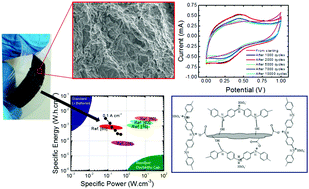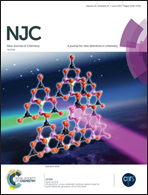The synthesis of highly corrugated graphene and its polyaniline composite for supercapacitors
Abstract
Graphene based composites and blends are potential candidates for fast and highly dense energy storage devices such as supercapacitors. Here is reported the preparation of highly corrugated graphene (CG) thin films onto plastic sheets of polyvinyl chloride (PVC) through thermal treatment using hydroiodic acid (HI) as the reducing agent. These films can be used as electrode materials for supercapacitors without the need for binders or metal current collectors. The films show a specific gravimetric capacitance of 170 F g−1 at 0.125 A g−1 and retains over 81% of their initial capacitance after 10 000 repeating cycles of charging/discharging. When the CG film is prepared in the presence of polyaniline (PANI), the resultant composite electrode (CG–PANI) presents a high specific gravimetric capacitance of 1041 F g−1, over 6 times greater than CG electrodes. Further, a symmetrical solid-state supercapacitor with CG–PANI electrodes is assembled by using a polyvinyl alcohol/sulfuric acid (PVA/H2SO4) gel electrolyte that shows an impressive volumetric energy density of 3.1 mW h cm−3 while maintaining a volumetric power density of 73.9 mW cm−3. This simple and costless effective preparation method of CG and its polyaniline composite can open up exciting opportunities for supercapacitor applications.



 Please wait while we load your content...
Please wait while we load your content...